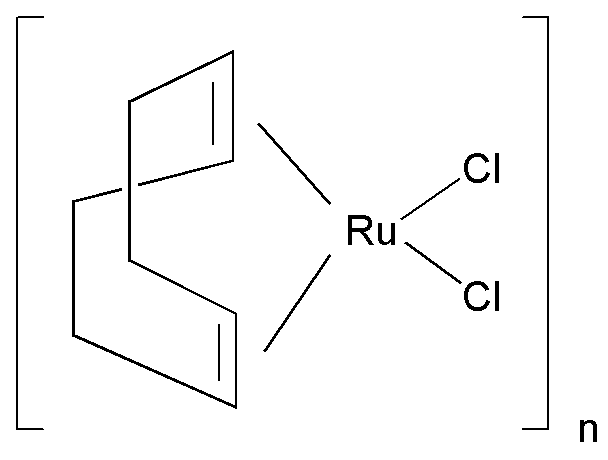Dichloro(1,5-cyclooctadien)ruthenium(II) polymer is widely utilized in research focused on:
- Catalysis: This compound serves as an effective catalyst in various organic reactions, enhancing reaction rates and selectivity, particularly in cross-coupling reactions.
- Material Science: It is used in the development of advanced materials, including polymers and nanocomposites, due to its ability to facilitate the formation of complex structures.
- Pharmaceuticals: The compound plays a role in drug development, particularly in synthesizing metal-based drugs that can target specific biological pathways.
- Environmental Chemistry: It is applied in processes aimed at pollutant degradation, contributing to cleaner production methods and waste reduction strategies.
- Electrochemistry: This chemical is utilized in the fabrication of electrodes for fuel cells and batteries, improving energy efficiency and storage capabilities.
General Information
Properties
Safety and Regulations
Applications
Dichloro(1,5-cyclooctadien)ruthenium(II) polymer is widely utilized in research focused on:
- Catalysis: This compound serves as an effective catalyst in various organic reactions, enhancing reaction rates and selectivity, particularly in cross-coupling reactions.
- Material Science: It is used in the development of advanced materials, including polymers and nanocomposites, due to its ability to facilitate the formation of complex structures.
- Pharmaceuticals: The compound plays a role in drug development, particularly in synthesizing metal-based drugs that can target specific biological pathways.
- Environmental Chemistry: It is applied in processes aimed at pollutant degradation, contributing to cleaner production methods and waste reduction strategies.
- Electrochemistry: This chemical is utilized in the fabrication of electrodes for fuel cells and batteries, improving energy efficiency and storage capabilities.
Documents
Safety Data Sheets (SDS)
The SDS provides comprehensive safety information on handling, storage, and disposal of the product.
Product Specification (PS)
The PS provides a comprehensive breakdown of the product’s properties, including chemical composition, physical state, purity, and storage requirements. It also details acceptable quality ranges and the product's intended applications.
Certificates of Analysis (COA)
Search for Certificates of Analysis (COA) by entering the products Lot Number. Lot and Batch Numbers can be found on a product’s label following the words ‘Lot’ or ‘Batch’.
*Catalog Number
*Lot Number
Certificates Of Origin (COO)
This COO confirms the country where the product was manufactured, and also details the materials and components used in it and whether it is derived from natural, synthetic, or other specific sources. This certificate may be required for customs, trade, and regulatory compliance.
*Catalog Number
*Lot Number
Safety Data Sheets (SDS)
The SDS provides comprehensive safety information on handling, storage, and disposal of the product.
DownloadProduct Specification (PS)
The PS provides a comprehensive breakdown of the product’s properties, including chemical composition, physical state, purity, and storage requirements. It also details acceptable quality ranges and the product's intended applications.
DownloadCertificates of Analysis (COA)
Search for Certificates of Analysis (COA) by entering the products Lot Number. Lot and Batch Numbers can be found on a product’s label following the words ‘Lot’ or ‘Batch’.
*Catalog Number
*Lot Number
Certificates Of Origin (COO)
This COO confirms the country where the product was manufactured, and also details the materials and components used in it and whether it is derived from natural, synthetic, or other specific sources. This certificate may be required for customs, trade, and regulatory compliance.


